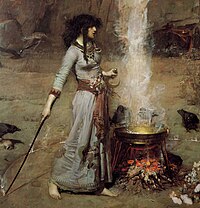This article is missing information about a full range of Asian countries. (August 2023) |

| Part of a series on |
| Witchcraft |
|---|
 |
Asian witchcraft encompasses various types of witchcraft practices across Asia. In ancient times, magic played a significant role in societies such as ancient Egypt and Babylonia, as evidenced by historical records. In the Middle East, references to magic can be found in the Torah and the Quran, where witchcraft is condemned due to its association with belief in magic, as it is within other Abrahamic religions.
In South Asia, there is continued witch-hunting and abuse of women accused of witchcraft in countries like India and Nepal. These deeply entrenched superstitions have perpetuated acts of violence and marginalization against those accused of witchcraft, underlining the urgent need for legal reforms and human rights protections to counter these alarming trends.
East Asia has diverse witchcraft traditions. In Chinese culture, the practice of Gong Tau involves black magic for purposes such as revenge and personal gain. Japanese folklore features witch figures who employ foxes as familiars. Korean history includes instances of individuals being condemned for using spells. The Philippines has its own tradition of witches, distinct from Western portrayals, with their practices often countered by indigenous shamans.